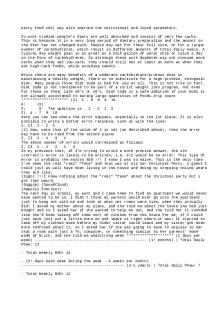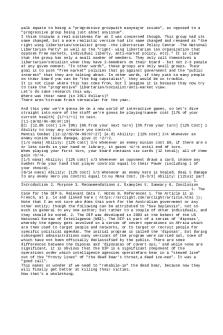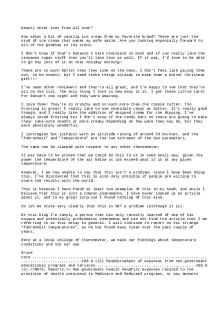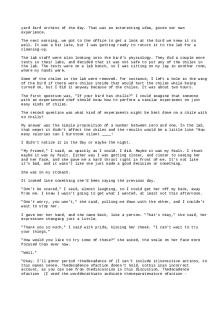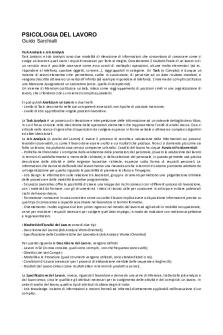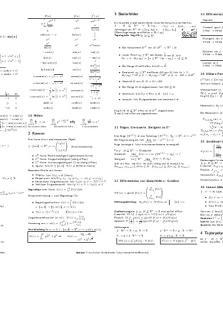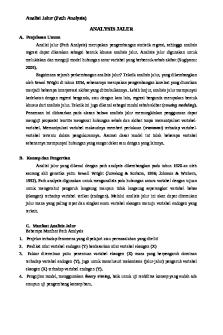Competitve Analysis PDF

| Title | Competitve Analysis |
|---|---|
| Author | Mary Tasarra |
| Course | Accounting Information Analysis |
| Institution | Ateneo de Naga University |
| Pages | 4 |
| File Size | 139.9 KB |
| File Type | |
| Total Downloads | 27 |
| Total Views | 142 |
Summary
analysis...
Description
Competitive Profile Matrix Starbucks Critical Success Factors
Dunkin
Weight
Score
Weighted Score
Score
Weighted Score
Price Competitiveness
0.10
2
0.20
4
0.40
Product Quality
0.13
4
0.52
3
0.39
Product Variety
0.11
3
0.33
2
0.22
Customer Loyalty
0.20
4
0.80
3
0.60
Customer Service
0.12
4
0.48
3
0. 36
Financial Position
0.08
3
0.24
2
0.18
Company Valuation
0.11
3
0.33
2
0.22
Market Expansion
0.15
3
0.45
3
0.45
Total Score
1.00
3. 35
2.82
4 = major strength 3 = minor strength 2 = minor weakness 1 = major weakness Interpretation The Competitive Analysis Matrix (CAM) presented are the common factors that affect both the internal and external operations of multinational companies such as Starbucks and Dunkin which are one of the major competitors in the coffee industry. As such, according to the matrix, Starbucks with a weighted score of 3. 38 is more competitive in the market than Dunkin Donuts which has a weighted score of 3.17. Data and or Information supporting Competitive Profile Matrix for Starbucks The multinational company that I chose to analyze is Starbucks and its competitor, Dunkin. I identify 8 critical success factors that comparatively assess the competitiveness of both— correspondingly, divided into three categories— first are price and product design, second is customer retention and third is the economic value of the multinational companies. In price and product design, the success factor to inspect is price competitiveness and product quality. In price competitiveness, Starbucks has a weighted average of 0.20 because it offers expensive commodities, thus, cannot cater to the masses resulting in low competitiveness in terms of pricing. According to Zach Lazzari, Starbucks ’ pricing strategy for profit maximization
is calculated on a standard of combining the target market and a premium approach to branding. The company believes that a strong brand identity drives sales despite expensive products, while Dunkin offers affordable prices, allowing the masses to purchase their commodities. With a weighted average of 0.40, Dunkin earns a competitive advantage in this aspect over Starbucks because the global pricing in the marketing mix of Dunkin plays a vital role in representing their dependency based on country purchasing power. It ensures that they offer high-quality products and is focusing on middle-class customers to ensure customer value. Indeed, the best choice for price-conscious consumers and cost-effective premium coffee. In product quality, Starbucks has a weighted average of 0.52 corresponding to its brand equity where the competitors cannot surpass. “The Starbucks Experience" a pedagogical approach reinforcing the concepts of quality control stirred as a competitive advantage of Starbucks— where customers do pay for a high-quality product and an experience all at once. Moreover, Starbucks customer is willing to pay a premium price for high-quality gourmet coffee beans just to experience it. Further, the company managed its supply chain to not compromise its supply chain activities. Similarly in Dunkin, with a weighted average of 0.39, the product strategy of the company is to deliver a consistent quality because it intended to be the lowest-cost producer in the market while having an above the minimum quality of products.
In product variety, Starbucks with a weighted average of 0.33 offers more variety of products than Dunkin with a weighted score of 0.22. Starbucks products variety comprises of exceptional products like Handcrafted Beverages: Fresh-brewed coffee, hot and iced espresso beverages, iced coffee, cold Brew, Nitro, Frappes and non-coffee blended beverages, and teas. Merchandises: Coffee and Tea Brewing Equipment, Mugs and Accessories, Packaged Goods and Book and Gifts. Pastries: La Boulange products. Snacks: Chips and crackers and some seasonal products Furthermore, Starbucks has built a more premium brand than Dunkin' Donuts. Starbucks offers an extensive menu and product customization and creates trends in the coffee business, On the other hand, Dunkin only offers iced and hot coffee, iced and hot chocolate, teas, their signature donut, and sandwiches. Dunkin’s products comprise 65% drinks, 8% donuts, and 27% of other food items, and they resemble more traditional fast-food restaurants. In the second category of customer retention, The customer loyalty of Starbucks with a weighted average of 0.80, is one of the best quality of Starbucks earning them an advantage over Dunkin with only an average of 0.60. “The Starbucks Experience” becomes an important factor contributing to customer loyalty despite its expensive products. The Starbucks experience just not offers a high-quality product but also offers a comfortable environment encouraging customers to socialize, study while consuming Starbucks exceptional commodities. Starbucks’ revolutionized its concept to target high-income, high-spenders, and healthy-ish professionals. Over time, Starbucks ’ layout of their physical stores gives the customer a satisfaction only the company can provide. Meanwhile, Dunkin’s aura is common, nothing to experience, and just a go-to cafe in a small amount of time. In a survey, The Dunkin’ customer is more blue-collar, casual, and looking for good coffee and a quick stop. Dunkin Customer loyalty is low because
there are many alternatives to the products it offers. In donut, Krispy Kreme, J.Co, and Mister Donut give reasonable factors in the consumer decision process. In the aspect of customer service, Starbucks still has an advantage as compared to Dunkin with a difference of 0.12 in the weighted score. Starbucks proffers series of rewards and collectibles to its customers. Today, Starbucks became a symbol of social class that one wanted to collect Starbucks cards and other items for their satisfaction. Besides, Starbucks continuously solicits feedback from customers includes but are not limited to direct feedbacking at the counter or through Starbucks Customer Connections, questionnaires on their Corporate Social Responsibility which became the basis on how to improve their operations. Likewise, Starbucks has a quality table where it demonstrates the relationship and engagement between the customer requirements and companies’ solutions. It layouts that the company blossoms to meet all the requirements of the customers while Dunkin only caters to the minimum acceptable quality of products at a low-cost. Dunkin' is notable for convenient customer service, being able to quickly serve products to customers. Donuts uses 100-percent Arabica coffee beans and has its own coffee specifications, which are recognized by the industry as a superior grade of coffee. Dunkin also offers a reward program known as “DD perks” In terms of complaints, both the company have their customer service department that caters to the concerns of the customer from products to staffing.
In the third category, the economic value, the Financial Position of the companies shows that Starbucks has an advantage compared to Dunkin with a weighted average of 0.24 than the latter which has only 0.18. The basis of financial position is the current ratio, total debt-equity, and debt ratio. Starbucks has a higher current ratio amounting to 1.96 than Dunkin with 1.38. The current ratio is the measurement of the company’s ability to pay short-term obligations. Regarding Total Debt-Equity, Dunkin has a higher ratio of 3.32 than Starbucks with only 0.64. The ratio shows that Starbucks has lower risk and lower leverage because a low debt-equity ratio is favorable from an investment viewpoint, still, Dunkin is associated with high risk, it can potentially generate more earnings. Lastly, Starbucks Debt ratio is 0.07, and Dunkin’s is 0.46 and it is considered that the lower the debt ratios, the better.
Company Valuation is all about determining the economic value of the business. I identified it as one of the critical success factors because the valuation entails the sales value, book value, and/or liquidation value of a company. In connection, Starbucks has a 0.33 weighted average while Dunkin has only a 0.22 weighted score because Dunkin’s company worth is $8.76 billion in cash or $106.50 per share while Starbucks is $19.21 billion or 107.00 per share. Besides, Starbucks profitability generates over $26 billion in revenue in a year while Dunkin’s annual revenue amounted to $1.5 billion. Lastly, the expected growth rate of Starbucks is 6% worldwide by 2030 while Dunkin expects 3.98% growth.
For the last critical success factor, Market Expansion, Starbucks and Dunkin have the same weighted average of 0.45 because both expand globally. Starbucks may have a larger footprint of above 30, 000 locations worldwide compared to Dunkin 11, 300 restaurants in states and international across 48 countries but both have excelled in this camaraderie. The expansion provides growth and opportunity for the company to move forward and enter new markets. Additionally, both companies plan to open new stores domestically and internationally as Dunkin will expand through franchising while Starbucks will expand as a company-owned business. The Competitive Profile Matrix alongside the critical success factors, weight, score, and weighted averages was based on my research on information from different companies accessed through the world wide web. The information given pertains that the competition between the 2 multinational companies is vigorous and really impacts the market in the coffee industries. Still, these companies have different target consumers, one is for cost-effective premium coffee and one is expensive coffee for a special atmosphere and I believe that they will not damage each other because Starbucks is the coffee giant while Dunkin is a top donut provider offering market differentiation in their products to sell.
1....
Similar Free PDFs
Popular Institutions
- Tinajero National High School - Annex
- Politeknik Caltex Riau
- Yokohama City University
- SGT University
- University of Al-Qadisiyah
- Divine Word College of Vigan
- Techniek College Rotterdam
- Universidade de Santiago
- Universiti Teknologi MARA Cawangan Johor Kampus Pasir Gudang
- Poltekkes Kemenkes Yogyakarta
- Baguio City National High School
- Colegio san marcos
- preparatoria uno
- Centro de Bachillerato Tecnológico Industrial y de Servicios No. 107
- Dalian Maritime University
- Quang Trung Secondary School
- Colegio Tecnológico en Informática
- Corporación Regional de Educación Superior
- Grupo CEDVA
- Dar Al Uloom University
- Centro de Estudios Preuniversitarios de la Universidad Nacional de Ingeniería
- 上智大学
- Aakash International School, Nuna Majara
- San Felipe Neri Catholic School
- Kang Chiao International School - New Taipei City
- Misamis Occidental National High School
- Institución Educativa Escuela Normal Juan Ladrilleros
- Kolehiyo ng Pantukan
- Batanes State College
- Instituto Continental
- Sekolah Menengah Kejuruan Kesehatan Kaltara (Tarakan)
- Colegio de La Inmaculada Concepcion - Cebu

